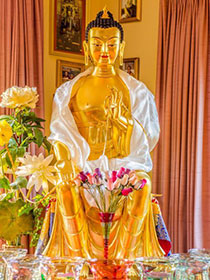- Home
- FPMT Homepage
Foundation for the Preservation of the Mahayana Tradition
The FPMT is an organization devoted to preserving and spreading Mahayana Buddhism worldwide by creating opportunities to listen, reflect, meditate, practice and actualize the unmistaken teachings of the Buddha and based on that experience spreading the Dharma to sentient beings. We provide integrated education through which people’s minds and hearts can be transformed into their highest potential for the benefit of others, inspired by an attitude of universal responsibility and service. We are committed to creating harmonious environments and helping all beings develop their full potential of infinite wisdom and compassion. Our organization is based on the Buddhist tradition of Lama Tsongkhapa of Tibet as taught to us by our founders Lama Thubten Yeshe and Lama Thubten Zopa Rinpoche.
- Willkommen
Die Stiftung zur Erhaltung der Mahayana Tradition (FPMT) ist eine Organisation, die sich weltweit für die Erhaltung und Verbreitung des Mahayana-Buddhismus einsetzt, indem sie Möglichkeiten schafft, den makellosen Lehren des Buddha zuzuhören, über sie zur reflektieren und zu meditieren und auf der Grundlage dieser Erfahrung das Dharma unter den Lebewesen zu verbreiten.
Wir bieten integrierte Schulungswege an, durch denen der Geist und das Herz der Menschen in ihr höchstes Potential verwandelt werden zum Wohl der anderen – inspiriert durch eine Haltung der universellen Verantwortung und dem Wunsch zu dienen. Wir haben uns verpflichtet, harmonische Umgebungen zu schaffen und allen Wesen zu helfen, ihr volles Potenzial unendlicher Weisheit und grenzenlosen Mitgefühls zu verwirklichen.
Unsere Organisation basiert auf der buddhistischen Tradition von Lama Tsongkhapa von Tibet, so wie sie uns von unseren Gründern Lama Thubten Yeshe und Lama Thubten Zopa Rinpoche gelehrt wird.
- Bienvenidos
La Fundación para la preservación de la tradición Mahayana (FPMT) es una organización que se dedica a preservar y difundir el budismo Mahayana en todo el mundo, creando oportunidades para escuchar, reflexionar, meditar, practicar y actualizar las enseñanzas inconfundibles de Buda y en base a esa experiencia difundir el Dharma a los seres.
Proporcionamos una educación integrada a través de la cual las mentes y los corazones de las personas se pueden transformar en su mayor potencial para el beneficio de los demás, inspirados por una actitud de responsabilidad y servicio universales. Estamos comprometidos a crear ambientes armoniosos y ayudar a todos los seres a desarrollar todo su potencial de infinita sabiduría y compasión.
Nuestra organización se basa en la tradición budista de Lama Tsongkhapa del Tíbet como nos lo enseñaron nuestros fundadores Lama Thubten Yeshe y Lama Zopa Rinpoche.
A continuación puede ver una lista de los centros y sus páginas web en su lengua preferida.
- Bienvenue
L’organisation de la FPMT a pour vocation la préservation et la diffusion du bouddhisme du mahayana dans le monde entier. Elle offre l’opportunité d’écouter, de réfléchir, de méditer, de pratiquer et de réaliser les enseignements excellents du Bouddha, pour ensuite transmettre le Dharma à tous les êtres. Nous proposons une formation intégrée grâce à laquelle le cœur et l’esprit de chacun peuvent accomplir leur potentiel le plus élevé pour le bien d’autrui, inspirés par le sens du service et une responsabilité universelle. Nous nous engageons à créer un environnement harmonieux et à aider tous les êtres à épanouir leur potentiel illimité de compassion et de sagesse. Notre organisation s’appuie sur la tradition guéloukpa de Lama Tsongkhapa du Tibet, telle qu’elle a été enseignée par nos fondateurs Lama Thoubtèn Yéshé et Lama Zopa Rinpoché.
Visitez le site de notre Editions Mahayana pour les traductions, conseils et nouvelles du Bureau international en français.
Voici une liste de centres et de leurs sites dans votre langue préférée
- Benvenuto
L’FPMT è un organizzazione il cui scopo è preservare e diffondere il Buddhismo Mahayana nel mondo, creando occasioni di ascolto, riflessione, meditazione e pratica dei perfetti insegnamenti del Buddha, al fine di attualizzare e diffondere il Dharma fra tutti gli esseri senzienti.
Offriamo un’educazione integrata, che può trasformare la mente e i cuori delle persone nel loro massimo potenziale, per il beneficio di tutti gli esseri, ispirati da un’attitudine di responsabilità universale e di servizio.
Il nostro obiettivo è quello di creare contesti armoniosi e aiutare tutti gli esseri a sviluppare in modo completo le proprie potenzialità di infinita saggezza e compassione.
La nostra organizzazione si basa sulla tradizione buddhista di Lama Tsongkhapa del Tibet, così come ci è stata insegnata dai nostri fondatori Lama Thubten Yeshe e Lama Zopa Rinpoche.
Di seguito potete trovare un elenco dei centri e dei loro siti nella lingua da voi prescelta.
- 欢迎 / 歡迎
简体中文
“护持大乘法脉基金会”( 英文简称:FPMT。全名:Foundation for the Preservation of the Mahayana Tradition) 是一个致力于护持和弘扬大乘佛法的国际佛教组织。我们提供听闻,思维,禅修,修行和实证佛陀无误教法的机会,以便让一切众生都能够享受佛法的指引和滋润。
我们全力创造和谐融洽的环境, 为人们提供解行并重的完整佛法教育,以便启发内在的环宇悲心及责任心,并开发内心所蕴藏的巨大潜能 — 无限的智慧与悲心 — 以便利益和服务一切有情。
FPMT的创办人是图腾耶喜喇嘛和喇嘛梭巴仁波切。我们所修习的是由两位上师所教导的,西藏喀巴大师的佛法传承。
繁體中文
護持大乘法脈基金會”( 英文簡稱:FPMT。全名:Found
ation for the Preservation of the Mahayana Tradition ) 是一個致力於護持和弘揚大乘佛法的國際佛教組織。我們提供聽聞, 思維,禪修,修行和實證佛陀無誤教法的機會,以便讓一切眾生都能 夠享受佛法的指引和滋潤。 我們全力創造和諧融洽的環境,
為人們提供解行並重的完整佛法教育,以便啟發內在的環宇悲心及責 任心,並開發內心所蘊藏的巨大潛能 — 無限的智慧與悲心 – – 以便利益和服務一切有情。 FPMT的創辦人是圖騰耶喜喇嘛和喇嘛梭巴仁波切。
我們所修習的是由兩位上師所教導的,西藏喀巴大師的佛法傳承。 察看道场信息:
- FPMT Homepage
- News/Media
-
- Study & Practice
-
-
- About FPMT Education Services
- Latest News
- Programs
- New to Buddhism?
- Buddhist Mind Science: Activating Your Potential
- Heart Advice for Death and Dying
- Discovering Buddhism
- Living in the Path
- Exploring Buddhism
- FPMT Basic Program
- FPMT Masters Program
- FPMT In-Depth Meditation Training
- Maitripa College
- Lotsawa Rinchen Zangpo Translator Program
- Universal Education for Compassion & Wisdom
- Online Learning Center
-
- Prayers & Practice Materials
- Overview of Prayers & Practices
- Full Catalogue of Prayers & Practice Materials
- Explore Popular Topics
- Benefiting Animals
- Chenrezig Resources
- Death & Dying Resources
- Lama Chopa (Guru Puja)
- Lama Zopa Rinpoche: Compendium of Precious Instructions
- Lama Zopa Rinpoche: Life Practice Advice
- Lama Zopa Rinpoche Practice Series
- Lamrim Resources
- Mantras
- Prayer Book Updates
- Purification Practices
- Sutras
- Thought Transformation (Lojong)
- Audio Materials
- Dharma Dates - Tibetan Calendar
- Translation Services
- Publishing Services
- Ways to Offer Support
- Prayers & Practice Materials
-
- Teachings and Advice
- Find Teachings and Advice
- Lama Zopa Rinpoche Advice Page
- Lama Zopa Rinpoche: Compendium of Precious Instructions
- Lama Zopa Rinpoche Video Teachings
- ༧སྐྱབས་རྗེ་བཟོད་པ་རིན་པོ་ཆེ་མཆོག་ནས་སྩལ་བའི་བཀའ་སློབ་བརྙན་འཕྲིན།
- Podcasts
- Lama Yeshe Wisdom Archive
- Buddhism FAQ
- Dharma for Young People
- Resources on Holy Objects
- Teachings and Advice
-
-
*If a menu item has a submenu clicking once will expand the menu clicking twice will open the page.
-
-
- Centers
-
- Teachers
-
- Projects
-
-
-
-
*If a menu item has a submenu clicking once will expand the menu clicking twice will open the page.
-
-
- FPMT
-
-
-
-
-
Letting go of attachment brings inner satisfaction and peace.
Lama Zopa Rinpoche
-
-
-
- Shop
-
-
-
The Foundation Store is FPMT’s online shop and features a vast selection of Buddhist study and practice materials written or recommended by our lineage gurus. These items include homestudy programs, prayers and practices in PDF or eBook format, materials for children, and other resources to support practitioners.
Items displayed in the shop are made available for Dharma practice and educational purposes, and never for the purpose of profiting from their sale. Please read FPMT Foundation Store Policy Regarding Dharma Items for more information.
-
-
FPMT News Around the World
4
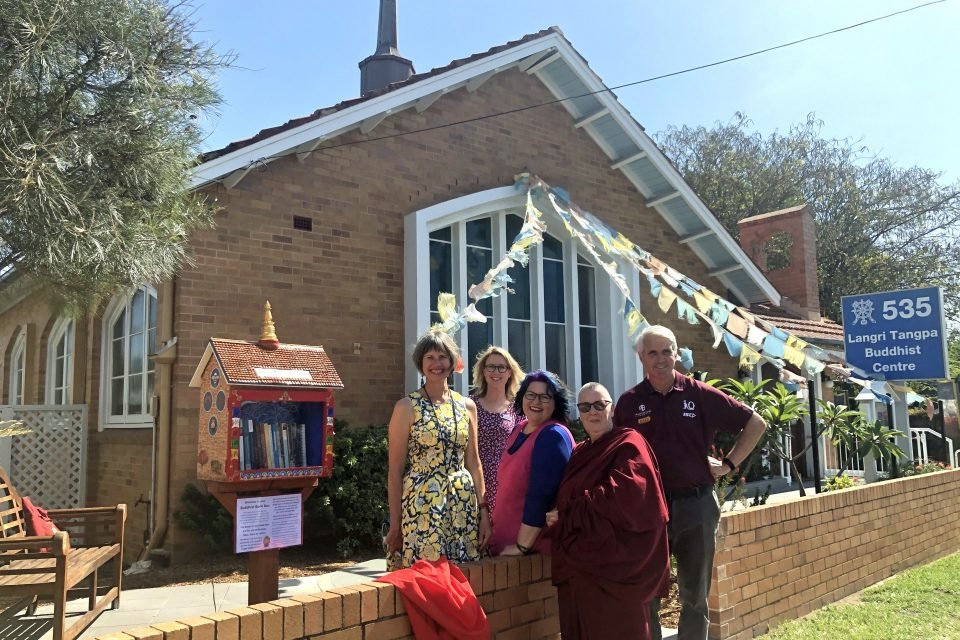
LTC then-director Maureen McIntyre, Councillor Fiona Cunningham, Helene Holland, Ven. Trin-la, and MP Joe Kelly opened the Street Library in a small ceremony, Langri Tangpa Centre, Brisbane, Queensland, Australia, November 2020. Photo by Carolyn Mason.
Langri Tanga Centre (LTC), the FPMT center in Brisbane, Queensland, Australia, used a US$300 International Merit Box Project grant they received in 2019 to create a “Street Library” on the center’s outside property. The International Merit Box Project was created in 2001 to cultivate generosity as part of a daily practice. The offerings made by students, centers, projects and services are annually disbursed as grants supporting a wide range of Dharma activity. Street Libraries, also known as Little Free Libraries, are part of a worldwide movement to create places for books to be read and shared in local communities.
LTC’s US$300 grant used to pay for the creation of the library box, including mounting and shipping it to the center, as well as materials for the design of the library box itself. Some money was put in by the center, and then an amount equivalent to approximately US$600 was provided in donations of time, money, and resources to create the space for the Street Library, with seating and landscaping around it. Carolyn Mason, a member of the LTC management committee, shares the story.
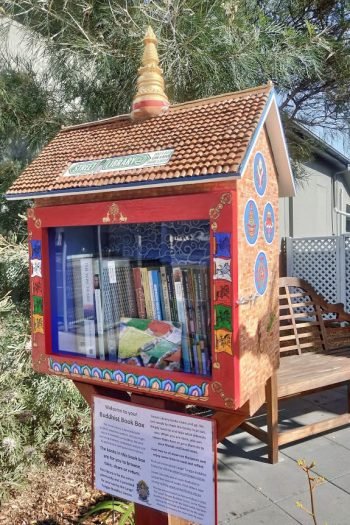
Street Library, Langri Tangpa Centre, Brisbane, Queensland, Australia, November 2020. Photo by Carolyn Mason.
The amazing biography Big Love: The Life and Teachings of Lama Yeshe, written by Adele Hulse and published by Lama Yeshe Wisdom Archive, tells the following story on page 663. It took place in 1978, during the first Council for the Preservation of the Mahayana Tradition at the then Manjushri Institute in England:
“Stepping outside after one meeting session, Lama Yeshe looked up at the Priory’s soaring Gothic spires and said to Nick Ribush, ‘You know, dear, I think we should buy every Christian church in the world!’ Surprised, ‘Er, yes Lama,‘ was all Nick could offer. Just one more example of Lama thinking big.”
In 2007, the Management Committee of Langri Tangpa Centre together with benefactors did just that—we bought a church in Brisbane. In 2020, we built a mini one with the creation of a Street Library, our Buddhist Book Box, opening it to the public in a small ceremony held on November 4.
The LTC Street Library:
- Spreads the Dharma further into our community through providing free books.
- Contains appropriate Dharma books, books donated by students, old library books, and postcards about LTC.
- Library and seated area are skillful means to bring people to the center.
- Encourages those people curious about Buddhism but not yet ready to come into the center.
- Prior to COVID-19, many new attendees heard about LTC by walking or driving by, so we hope the Street Library will generate more interest for this group.
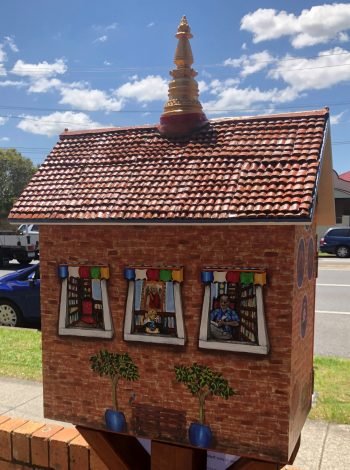
Street Library, Langri Tangpa Centre, Brisbane, Queensland, Australia, November 2020. Photo by Carolyn Mason.
Created by our wonderful volunteer artist Helene Holland, it’s the most beautiful exquisitely detailed mini-LTC you ever did see! It has bricks and tiles, and the tip of the roof has a stupa instead of a spire.
Helene spent many hours decorating it with paint and hundreds of hand-made tiles (complete with moss!). The back of the Street Library is decorated with windows that “look” into LTC’s library. The sides of it have the church building’s brick pattern and are decorated with auspicious symbols. Prayer flags are on the front of the Street Library.
Helene is a skilled artist. She has regularly completed workshops with Andy Weber and conducts art classes herself, as well as painting stupas, molding and painting auspicious symbols for the center, and completing repairs on holy objects.
Our Street Library has a solar powered mini-chandelier inside, and the blue-painted interior and row of books draw the eye, especially in the dark. So far over 80 books have been borrowed! We just keep filling it up with books donated to the center.
We are now literally on the (Street Library) map in Australia, becoming the 2,500th Street Library in the country. We dedicate that this becomes a welcoming bridge from our passersby to the Buddhadharma.
To learn more about Langri Tangpa Centre, visit their website:
https://langritangpa.org.au/
If you would like start accumulating offerings with your own Merit Box practice, you can order a free Merit Box for your home or office altar from the FPMT Foundation Store:
https://shop.fpmt.org/Merit-Box-_p_619.html
FPMT.org and Mandala Publications brings you news of Lama Zopa Rinpoche and of activities, teachings, and events from over 160 FPMT centers, projects, and services around the globe. If you like what you read, consider becoming a Friend of FPMT, which supports our work.
- Tagged: andy weber, carolyn mason, helene holland, international merit box project, langri tangpa centre, merit box, merit box grants
28
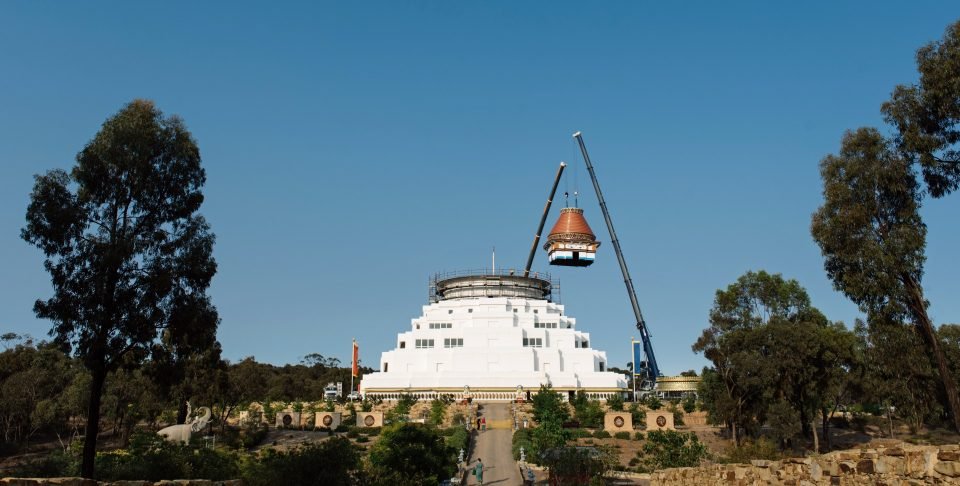
The Great Stupa of Universal Compassion, Bendigo, Victoria, Australia, January 2020. Photo by Alyce Crosbie.
In 1981, Lama Thubten Yeshe laid out the original plans for the Great Stupa of Universal Compassion, an FPMT project near Bendigo in Victoria, Australia. On Tuesday, December 17, 2019, the community celebrated as the final pieces of the Great Stupa were lifted into place. Alyce Crosbie, marketing and events coordinator, shares that story and others in this update on activities at the stupa during 2020 and the Coronavirus pandemic.
“Raising the top of the stupa is a once-in-a-millennium moment in what we plan to be the 1,000-year life of the Great Stupa,” said Ian Green, director and chairman of the project since its inception. “It must be what it felt like for the builders of the great cathedrals or mosques of the world when the final spire or domes were put in place.”
Two massive cranes lifted the final structures—the sokshing, harmika, thirteen rings, and parasol—into place. The harmika and the thirteen rings alone weigh around 30 metric tons (33 US tons). The last 19 meters (62 feet) are completely decorated with traditional Buddhist artwork done by a team of local artists as well as custom-made works done in Nepal.
“For the past sixteen years, we have been focused on concrete and steel,” Ian Green said. “But the top of the stupa will be fully decorated in the brilliant colors of traditional Buddhist iconography. It gives us a real sense of how spectacular the whole stupa will be when complete.”
The Great Stupa had been standing close to 30 meters (98 feet) high and has now reached its total height of 48 meters (157 feet).
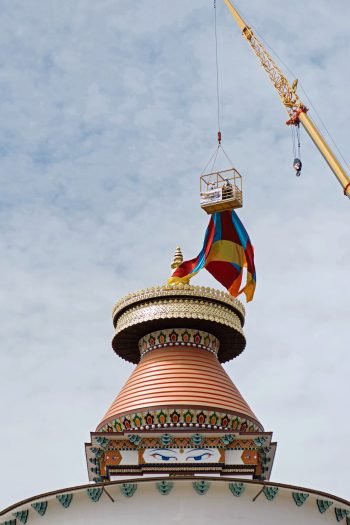
The Great Stupa of Universal Compassion, Bendigo, Victoria, Australia, January 2020. Photo by Alyce Crosbie.
The top of the Great Stupa was unveiled in a spectacular ceremony one month later. The mayor of the City of Greater Bendigo, two local members of parliament, and Ian Green were hoisted 60 meters (197 feet) above the ground in a “man cage” from which they lifted a veil off the top of the stupa. The unveiling was part of the Lunar New Year celebrations held at the stupa in January and February, one of our three major annual events.
Behind-the-scenes construction projects have continued during the COVID-19 pandemic. These included renovating and extending the gift shop as well as major earthworks for a sewage and water filtration system to make the site as self-sustainable as possible.
Ian Green reported that the services works projects have been successfully completed even though progress was impacted by the COVID-19 pandemic. He said, “It has slowed down our work due to delays in provision of important component parts and competition for contractors due to high demand created by government housing incentives. At the same time the pandemic closures at the Great Stupa, which were over five months, did enable some major trenching that would have been difficult to handle if we had our normal number of visitors to the stupa.”
Ian Green said, “A new power house will be the next major project at the stupa. This will include provision for solar power, batteries, and generators.”
There is a twelve-minute video virtual tour around the Peace Park at the Great Stupa, highlighting the interfaith installations in the park as well as the different plant and tree varieties. This video is part of the Bendigo “Bloom” garden series created by Bendigo Tourism to showcase the beautiful parks and gardens in our region.
Watch Alyce lead the “Bendigo Bloom – Peace Park Tour” at the Great Stupa for Universal Compassion:
https://youtu.be/YbB81Zw8f0I
We were preparing for an increase in visitors this year due to the completion of the outside of the building, but like most people we have felt the effects of COVID-19. We were hugely saddened to have to close our doors twice this year. This included canceling ILLUMIN8: Festival of Light and Peace, one of our three major annual events, when we celebrate the Buddha’s life on Saka Dawa with an amazing line-up of cultural performances and activities, light sculptures, food, and family fun.
Our Vegecareian Festival, a major annual event at the Great Stupa celebrating vegetarian cuisine from around the world, was held virtually for the first time. The November 21 livestream included cooking demonstrations, virtual animal blessings, and self-care activities. Thanks to everyone who tuned in on Facebook! For those of you who didn’t get a chance to join in, you can now watch the recording anytime on our YouTube channel. We look forward to seeing you and your pets for Vegecaerian Festival 2021.
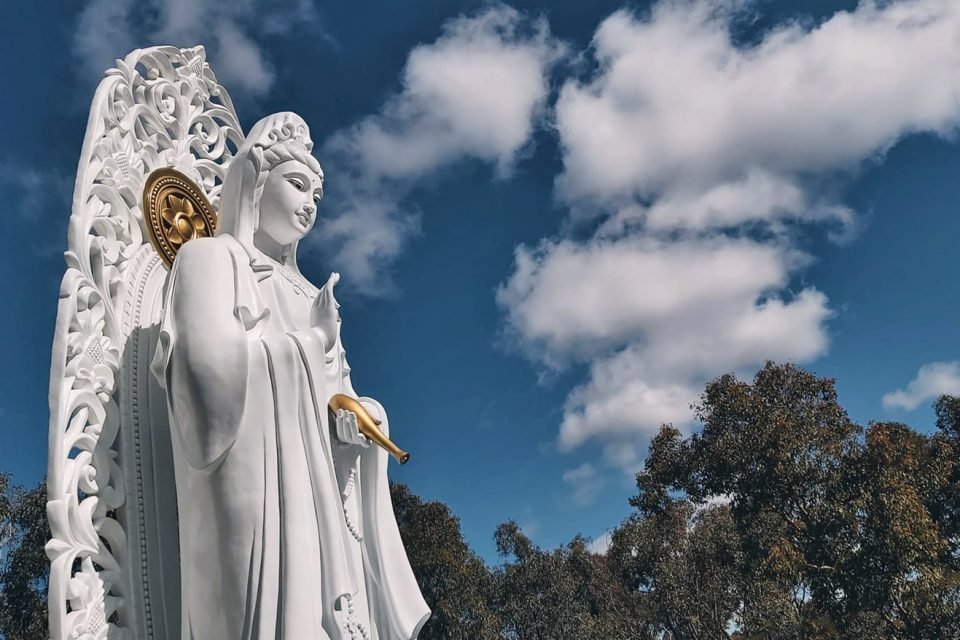
A 6 meters (23 feet) high Quan Yin statue, installed during the COVID-19 pandemic, overlooks the entire Peace Park at the Great Stupa of Universal Compassion, Bendigo, Victoria, Australia, August 2020. Photo by Alyce Crosbie.
To learn more about The Great Stupa of Universal Compassion and the Jade Buddha for Universal Peace visit the website:
https://www.stupa.org.au
FPMT.org and Mandala Publications brings you news of Lama Zopa Rinpoche and of activities, teachings, and events from over 160 FPMT centers, projects, and services around the globe. If you like what you read, consider becoming a Friend of FPMT, which supports our work.
21
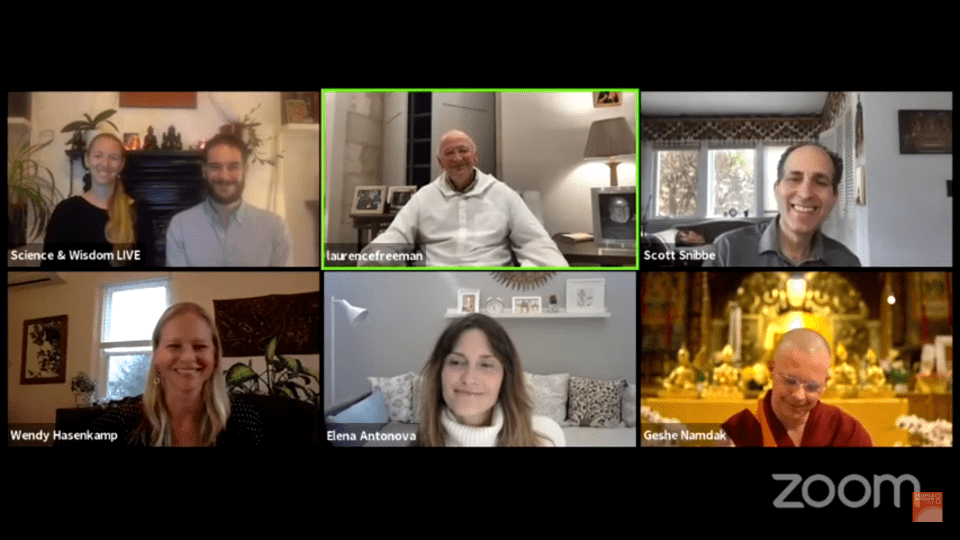
“Distorted Emotions and Destructive Perceptions,” November 2020. Photo courtesy of Science & Wisdom LIVE.
Jamyang Buddhist Centre, the FPMT center in London, UK, launched their new project, Science & Wisdom LIVE, on November 11, 2020, with a dialogue between two scientists and two contemplative practitioners. Project managers Marco Colnaghi and Dr. Sajda van der Leeuw share the story.
Science & Wisdom LIVE, supported by Mind & Life Europe, aims to bridge the gap between science and wisdom traditions by bringing scientists into conversation with contemplative practitioners on the biggest challenges of our times.
Science & Wisdom LIVE launched its program with an online dialogue on the topic of “Destructive Emotions & Distorted Perceptions.” The event was held on the traditional Remembrance Day, when we commemorate the first day of peace after World War I and remember the lives lost in war.
Two scientists, Dr. Elena Antonova, a senior lecturer in psychology at Brunel University London and a visiting researcher at the Institute of Psychiatry, Psychology, and Neuroscience (IoPPN), King’s College London, and Dr. Wendy Hasenkamp, science director of Mind & Life Institute, joined two contemplative practitioners, Geshe Tenzin Namdak, FPMT resident geshe at Jamyang Buddhist Centre, and Father Laurence Freeman, a Catholic priest and a Benedictine monk of Monastery of Sta Maria di Pilastrello in Italy and the Director of the World Community for Christian Meditation, for a lively discussion on negative emotions and their possible solutions. The event was moderated by Scott Snibbe, host and creator of the podcast “A Skeptic’s Path to Enlightenment.”
The dialogue began with an exploration of why we call certain emotions “negative” or “destructive” and how they can lead to patterns of behavior that bring suffering to ourselves and others. The speakers then launched into an inspired (and truly inspiring) exchange about the possible antidotes to non-virtuous states of mind, discussing how contemplative traditions offer us practical tools to release the grasp of negative emotions.
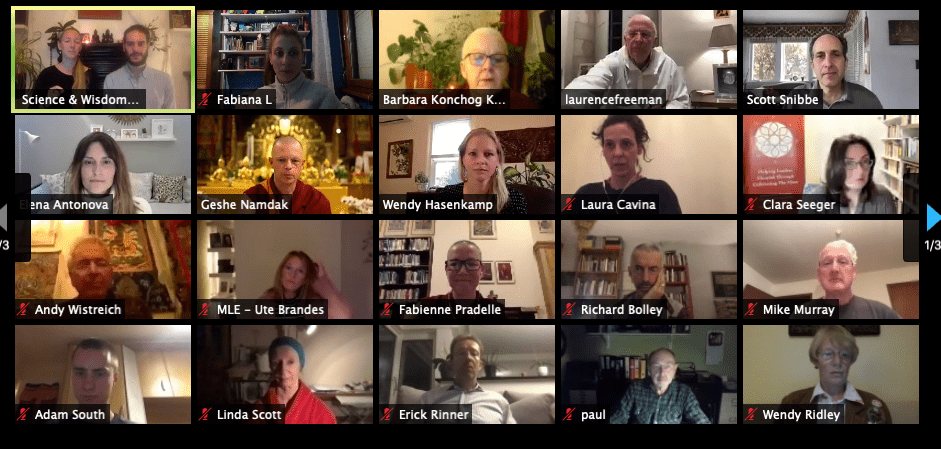
“Distorted Emotions and Destructive Perceptions,” November 2020. Photo courtesy of Science & Wisdom LIVE.
Dr. Elena Antonova and Dr. Wendy Hasenkamp reflected on the scientific approach to the study of our inner world and explored how recent scientific findings, such as neuroplasticity and social baseline theory, can inform a more constructive way of understanding our minds and thinking about emotions.
Dr. Elena Antonova said, “An accepted dogma on which a lot of our Western society is based—and which has dominated our baseline idea of the mental state—is the state of anxiety, survival, vigilance, and separation. (Because we also perceive animals primarily as being in a relationship of predator and prey.) However, some scientists suggest that we should entertain the possibility that serenity, contentment, and connectiveness is our primary baseline, but that this gets disturbed when we’re put in the state of flight or fight response.”
Dr. Wendy Hasenkamp explained, “We need to repattern these entrenched patterns that have been developed over the course of our lives—and potentially inter-generationally—which can be done in many ways. We are learning about neuroplasticity and neural patterning, and that there’s a capacity of the brain to change. We need to reactivate a pattern that’s already there, and then carve a different path. This comes close to contemplative traditions, where we have to sit with negative emotions and where we learn about the role of acceptance and how to lovingly embrace what’s happening to us, after which we can start to create a different pathway or outcome.”
Geshe Tenzin Namdak and Father Laurence Freeman offered their often poetic insights from their own practices and experiences with meditation.
Father Laurence Freeman said, “There’s a variety of spiritual practices, centered in meditation, that can release us from the pattern of the hold of these negative emotions over time, with support from others. … Essentially, as the Buddhist would say, we have Buddha nature—or as the Christians would say, we are in the image of God. We are a living icon of the Divine, yet we need to build up a likeness to God over a lifetime, through becoming aware of ourselves and our problems, and also hoping (and later on trusting) that at the core of our being is an essential goodness, compassion, and virtue.”
Geshe Tenzin Namdak remarked, “We have a potential of the mind, which Father Laurence mentioned is like icon nature, but then there is obscuration—the ‘clouds’ that obscure that nature. So we need to first find acceptance of the problem without getting involved in it (as a neutral observer). This will lead to acceptance and the ability to observe—instead of engaging with—destructive emotions. Then we can start to have an intention for change and repattern our mind accordingly. We then have a freedom before any emotional hijack sets in.”
Watch a four-minute excerpt of the November 11 dialogue on the Science & Wisdom LIVE YouTube channel:
https://youtu.be/TSzHK5lvpV0
A video recording of the full event will be published soon.
Science & Wisdom LIVE brings meditation practitioners into conversation with scientists to address the problems of contemporary society and come to new possible solutions. The Science & Wisdom LIVE dialogues are based on the ideas of societal wisdom, the deliberate use of human knowledge and experience to cultivate well-being.
As a long-term series, these dialogues aim to enrich our insight, wisdom, and understanding of mind and life. Each dialogue touches upon specific sub-themes where science and contemplative traditions intersect, such as the ethics of artificial intelligence, gender equality, climate change, and the benefits of mindfulness and meditation for mental health.
To learn more about Science & Wisdom LIVE, learn about upcoming events, and subscribe to their newsletter, visit their website:
www.sciwizlive.com
Follow Science & Wisdom LIVE on Facebook:
https://www.facebook.com/sciwizlive
Listen to interviews with the November 11 panelists and recordings of the event on the Science & Wisdom LIVE podcast:
https://www.sciwizlive.com/podcast-episodes/
FPMT.org and Mandala Publications brings you news of Lama Zopa Rinpoche and of activities, teachings, and events from over 160 FPMT centers, projects, and services around the globe. If you like what you read, consider becoming a Friend of FPMT, which supports our work.
- Tagged: geshe tenzin namdak, interfaith, jamyang buddhist centre, mind and life, science & wisdom live
17
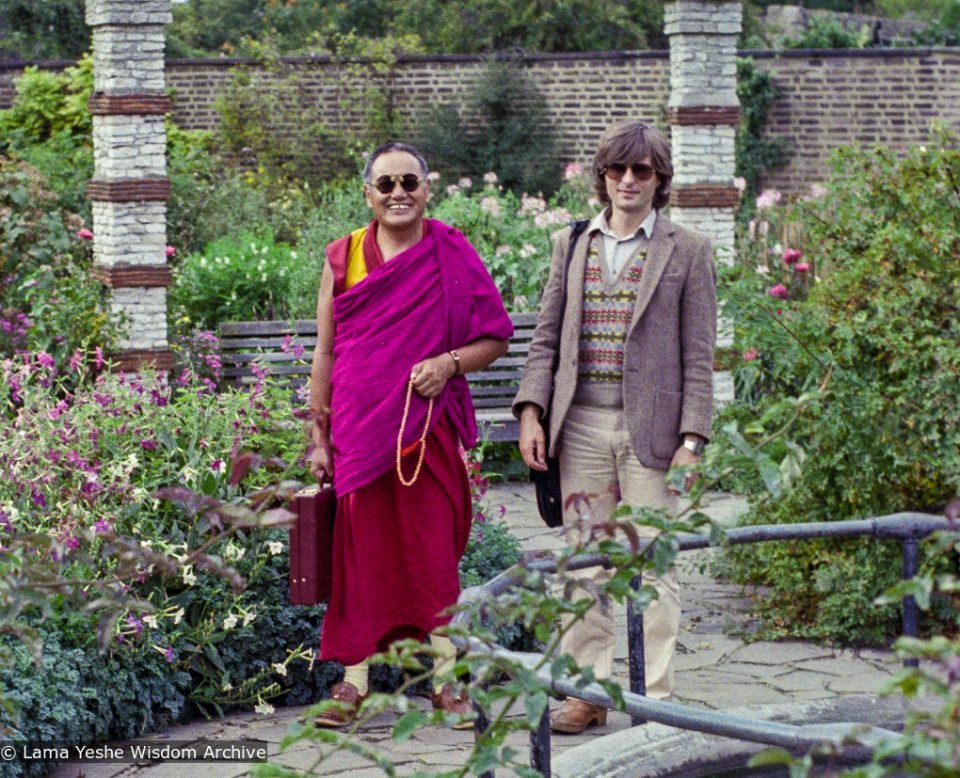
Lama Yeshe and Geoff Jukes, Kew Gardens, London, 1982. Photo courtesy Lama Yeshe Wisdom Archive.
For more than three decades, the Meridian Trust has been documenting on film and video Buddhist teachings and traditions around the world. The UK-based organization has collected an archive of more than 2,500 hours of footage, including rare footage of the generation of Tibetan lineage holders who first went into exile. Vicki Mackenzie shares the story of the Meridian Trust and its connection to FPMT in the new online story “Preserving the Past for Future Generations: The Meridian Trust Documents the Tibetan Buddhist Tradition as It Grows in the West.” Here’s a short excerpt from the story:
Unbeknown to most Buddhist students, there is a stash of hidden treasure accessible through a mere tap of the fingertip. Faces, voices and words of the most venerable masters who managed to escape from Tibet, video of His Holiness the Dalai Lama receiving the Nobel Peace prize, extraordinary footage from Tibet itself of its culture and historical events, and little gems of meetings between students and gurus. It’s accessible through the Meridian Trust website, an archive of over 2,500 hours of footage that has recorded the vanishing Tibetan traditions. And it is the brain child of Geoff Jukes, long term British student of Lama Yeshe and Lama Zopa Rinpoche, and manager of some of the biggest names in the British music industry.
“The late 1970s and early 1980s, was an extraordinary time to meet the Dharma,” Geoff said. “There seemed to be a seemingly unending supply of these very rare beings, who appeared in our midst, the repositories of the unique Tibetan culture that was rapidly vanishing. It became very clear to me what an extraordinary window of opportunity we had been given, and it wasn’t going to go on forever. I wanted to record and preserve it for future generations. I discussed it with Lama Yeshe, and he was very enthusiastic.” …
“For me, however, it’s the early films that are particularly precious because no-one else was doing it then,” said Geoff. “We caught some iconic FPMT moments such as His Holiness’s and Lama Yeshe’s teachings at Institut Vajra Yogini in France and at Istituto Lama Tsong Khapa in Italy in 1981. Many FPMT centers do not realize the special, iconic moments we’ve captured and which are available to them.” …
Read the complete online story “Preserving the Past for Future Generations: The Meridian Trust Documents the Tibetan Buddhist Tradition as It Grows in the West.”
Visit the Meridian Trust online to watch videos and learn more about the video archive. The Meridian Trust is expanding the scope of its online work in January 2021 with a new, updated website, which will include podcasts and articles covering a wide range of Dharma subjects.
FPMT.org and Mandala Publications brings you news of Lama Zopa Rinpoche and of activities, teachings, and events from over 160 FPMT centers, projects, and services around the globe. If you like what you read, consider becoming a Friend of FPMT, which supports our work.
13

Vens. Losang Gyaltsen and Lobsang Tendar, the previous and current Nalanda Monastery directors, receive the keys to the Gachepel property from previous property owner, Didier Leyrisse, Lavaur, France, October 2020. Photo by Ven. Losang Chodrak.
On October 12, 2020, Nalanda Monastery, the FPMT monastery in the South of France, celebrated a significant step in their project to develop a retreat location called Maitreya Pure Land. The nearby property, known as Gachepel, was handed over to the monastery in a symbolic moment.
Nalanda’s Facebook page narrated the photo they posted of the occasion: “The happy moment of receiving the key from the owner of Gachepel, the neighboring property. We managed to acquire it (with your enormous help) with a plan to transform it into a retreat place for both monastic and lay people. Maitreya Pure Land is a big step and also a big responsibility for Nalanda. Thank you all who made it possible! Let’s rejoice and pray that this project will be most beneficial for all sentient beings.”
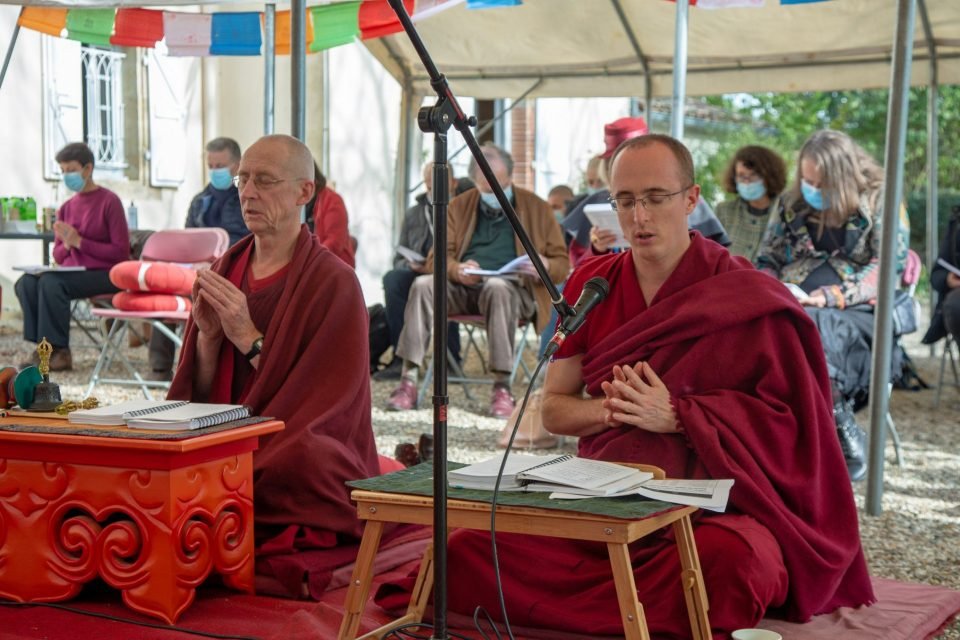
Geshe Tenzin Losel (Graham Woodhouse), Ven. Losang Gyaltsen, and lay people offering prayers at Maitreya Pure Land, Lavaur, France, October 2020. Photo by Ven. Künkhyen.
Maitreya Pure Land was inaugurated on October 24, 2020. The celebratory event included a visit to the new land, a community vegetarian lunch, speeches, prayers, and a ribbon cutting ceremony.
About the event, Nalanda Monastery wrote on Facebook, “Very happy moments! Maitreya Pure Land, our new retreat land, was recently inaugurated in the presence of Emmanuel Joulié, the mayor of Labastide-Saint-Georges, Gomde Rinpoche, Nalanda Monastery’s abbot Geshe Lobsang Jamphel, Geshe Jamphel Gyaltsen, Geshe Graham Woodhouse, and a great community of monks, nuns, and lay practitioners. All together we had about 100 visitors. The rainy days miraculously stopped and we were granted a beautiful sunny day. We all came together in the courtyard of our new retreat place and performed Lama Chöpa with Tsog Offering as well as ‘Praises to the 21 Taras.’
“Ven. Lobsang Tendar, Nalanda’s new director, expressed his gratitude, saying, ‘We are very very fortunate to have this beautiful property now. I hope it will benefit all sentient beings. Thanks to all sponsors who have contributed. Also, thanks to our teachers and holy beings: without their blessings nothing would happen.'”
Watch “Vision for Maitreya Pure Land – Retreat Place near Nalanda,” created by Ven. Thubten Zoksang, on YouTube:
https://youtu.be/RqZg93_8VXo
In October 2018, Nalanda Monastery learned of the possibility of purchasing Gachepel, a neighboring property which had been a family home for two hundred years, in a private sale from the owner. The agreed upon price was 1.2 million € (US$1,340,000).
The first donation, US$100,000, and the property’s new name, Maitreya Pure Land, were given by Lama Zopa Rinpoche when he visited Gachepel in June 2019. Later, Nalanda Monastery’s then director Vens. Losang Gyaltsen and current director Lobsang Tendar went on a fundraising tour. Nalanda Monastery successfully completed their fundraising campaign on March 19, 2020.
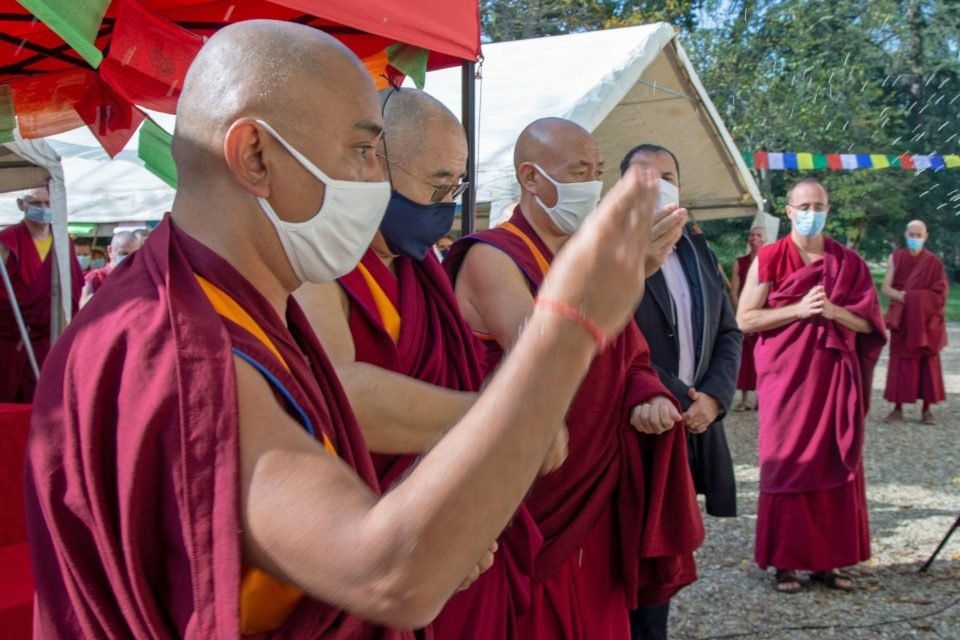
Gomde Rinpoche, Geshe Lobsang Jamphel, Geshe Jamphel Gyaltsen, and Mayor Emmanuel Joulié at Maitreya Pure Land, Lavaur, France, October 2020. Photo by Ven. Künkhyen.
Rinpoche said, “It would be excellent for those who have studied at Nalanda, both monastics and lay, to do semi-isolated retreats [at Maitreya Pure Land] in order to realize the teachings. Therefore, by acquiring Gachepel, Nalanda can provide a retreat center allowing monastic and lay practitioners to integrate and realize the Buddha’s teachings.
“The results from achieving this goal are many. Notably more Western practitioners will become qualified and experienced teachers, being able to benefit the Dharma and sentient beings. Also Gachepel will help to ensure the preservation of the complete Tibetan Buddhist tradition in the West.”
For more information about Nalanda Monastery, visit their website:
https://nalanda-monastery.eu/index.php/en/
For more information about Maitreya Pure Land, visit their website:
https://maitreya.nalanda-monastery.eu/
US$100,000 was offered toward the purchase of new retreat land for Nalanda Monastery in France. This land will be used to facilitate lamrim retreats. Rinpoche commented that it would be excellent for those who have studied at Nalanda, both monastics and lay people, to do semi-isolated retreats at this new retreat land in order to realize the teachings.
FPMT.org and Mandala Publications brings you news of Lama Zopa Rinpoche and of activities, teachings, and events from over 160 FPMT centers, projects, and services around the globe. If you like what you read, consider becoming a Friend of FPMT, which supports our work.
13
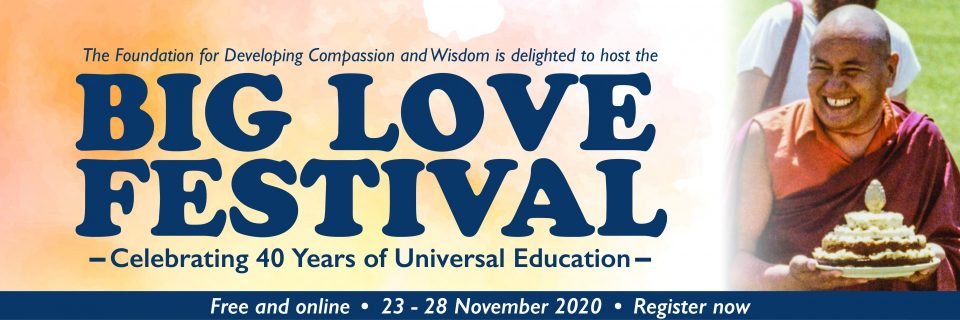
Lama Yeshe carrying a cheesecake mandala at Deer Park Buddhist Center, Madison, WI, US, 1978. Photo by Morgan Groves, courtesy of Lama Yeshe Wisdom Archive. Big Love Festival graphic by Michaela Kirchem.
Foundation for Developing Compassion and Wisdom (FDCW), an international FPMT project, will celebrate nearly forty years of Universal Education with the online Big Love Festival from Monday, November 23, to Saturday, November 28, 2020. FDCW’s programs are based on Universal Education for Compassion and Wisdom—a secular system of inner learning that cultivates and explores universal values such as humility, kindness, courage, compassion, and empathy—which is one of FPMT’s Five Pillars of Service. The Big Love Festival brings together fifteen speakers from a wide range of Universal Education projects to share how they have brought Universal Education into people’s lives in very practical ways. FDCW’s Executive Director, Victoria Coleman, shares the story.
Lama Thubten Yeshe first shared his vision for a Universal Education in the mid-1970s, and since then his unique and innovative approach has inspired many individuals and projects offered in schools, universities, hospices, workplaces, healthcare, youth groups, and community centers around the world. In an interview in 1983, Lama Yeshe described his radical idea in more depth. He said, “We have to get rid of people’s old concepts and give them a new imagination; a new, broad way of looking at themselves and the world. That’s what I mean by ‘universal.'”
The Big Love Festival is not only a celebration of what has been achieved but also an opportunity to gather ideas and inspiration to shape the next forty years of Universal Education in response to the challenges of the coronavirus pandemic, climate change, and social and economic inequality and injustice.
The list of speakers includes Tenzin Ösel Hita, Ven. Robina Courtin, Professor Jan Willis, and many more.
FDCW’s honorary president, Lama Zopa Rinpoche, will open the festival on Monday, November 23. His Holiness the Dalai Lama, patron of FDCW, has sent a written message on the occasion of the Big Love Festival. FDCW is delighted to be able to share this message with festival participants at the opening of the festival.
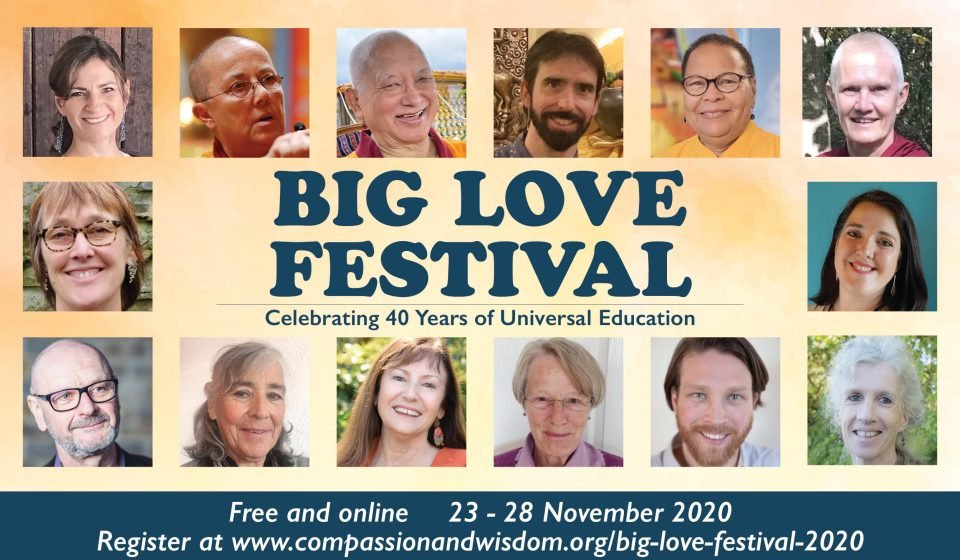
Big Love Festival, graphic by Michaela Kirchem.
The festival is open to all who are interested in creating a better, wiser, and more compassionate world. All sessions take place online and can be joined live and for free. FDCW is looking to make recordings of sessions available. Please register for the festival to receive regular updates.
FDCW was established in 2005 and provides training, programs, and resources inspired by the values and vision of Universal Education. FDCW’s programs are grounded in Buddhist teachings and presented in secular language using modern learning methods both online and in person. The focus is putting secular ethics into practice in everyday life.
Over the years FDCW’s programs have reached many thousands of people through a dedicated and growing network of 86 facilitators across 22 countries.
To learn more about the Foundation for Developing Compassion and Wisdom, visit the FDCW website: https://www.compassionandwisdom.org
FPMT.org and Mandala Publications brings you news of Lama Zopa Rinpoche and of activities, teachings, and events from over 160 FPMT centers, projects, and services around the globe. If you like what you read, consider becoming a Friend of FPMT, which supports our work.
- Tagged: foundation for developing compassion and wisdom, jan willis, lama yeshe, michaela kirchem, osel, osel hita, tenzin osel hita, universal education, universal education pillar, ven. robina courtin, victoria coleman
2
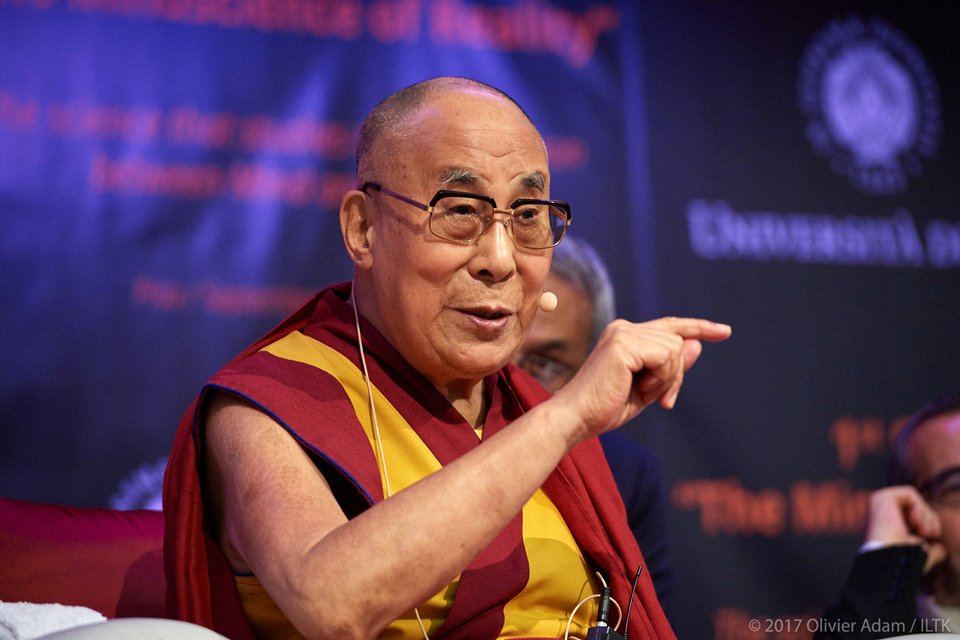
His Holiness the Dalai Lama at the Mindscience of Reality Symposium, organized by Istituto Lama Tzong Khapa and Università di Pisa, Pisa, Italy, September 2017. Photo by Olivier Adam.
His Holiness the Dalai Lama will join a live online event celebrating the publication of Science and Philosophy in the Indian Buddhist Classics, Volume 2: The Mind. Wisdom Publications is hosting the live book launch on Friday, November 13, at 9 a.m. India Standard Time (UTC +5:30); Thursday, November 12, at 10:30 p.m. Eastern Standard Time (UTC -5; for more time zones, please see Time Zone Converter).
The Mind is the second volume in the Science and Philosophy in the Indian Buddhist Classics series, focusing on the science of mind. The series is the English translation of a compilation of texts drawn from the Kangyur and Tengyur, which discusses the physical world, mind science, and Buddhist philosophy. Described as a heart-project of His Holiness, a committee of Tibetan geshes created this compendium, which was published in Tibetan in 2014 as four volumes. Translations of these volumes are being made into Chinese, English, Italian, and other languages.
In this second volume, readers are introduced to Buddhist conceptions of mind and consciousness and then led through traditional presentations of mental phenomena to reveal a Buddhist vision of the inner world with implications for the contemporary disciplines of cognitive science, psychology, emotion research, and philosophy of mind.
In addition to His Holiness, the book launch features the following guests: Daniel Aitken, CEO & Publisher, Wisdom Publications; Geshe Thupten Jinpa, series editor; Dechen Rochard, translator; and John D. Dunne, author of contextual essays and translator.
“What could be more central to Buddhism than the mind? As the opening verse of the Dhammapada says, ‘mind is the basis for everything,’” writes José Ignacio Cabezón, Dalai Lama Professor of Tibetan Buddhism and Cultural Studies, University of California Santa Barbara. “This groundbreaking volume introduces the reader to the most important Buddhist ideas about the mind—its nature, types, workings, and the techniques that Buddhists through the centuries have used to transform it. A truly indispensable sourcebook.”
For more information and to sign up to watch His Holiness the Dalai Lama live, please visit the The Mind book launch page on WisdomExperience.org.
You can read an excerpt of His Holiness’s introduction to the first volume of the Science and Philosophy in the Indian Buddhist Classics series, The Physical World, published by Wisdom Publications in November 2017, from Mandala January–June 2018: “A Gift of Insight: Buddhist Mind Science and Philosophy.”
Find more live online teachings and talks with His Holiness at DalaiLama.com/live.
FPMT.org and Mandala Publications brings you news of Lama Zopa Rinpoche and of activities, teachings, and events from over 160 FPMT centers, projects, and services around the globe. If you like what you read, consider becoming a Friend of FPMT, which supports our work.
28
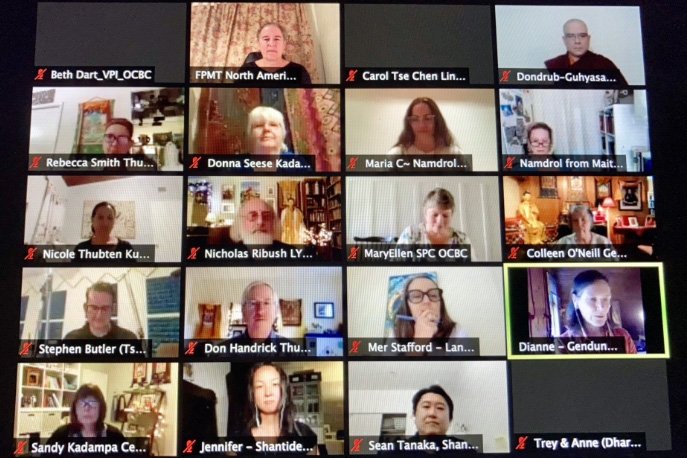
Some of the FPMT North America Regional Meeting participants on Zoom, September 2020. Photo by Drolkar McCallum.
At the end of September 2020, Drolkar McCallum, regional coordinator for FPMT North America and office manager for the International Mahayana Institute—FPMT’s international community of nuns and monks—held a successful and highly enjoyable regional meeting. Drolkar offered her reflections.
This was the first time that we had the North American regional meeting online, but our two-hour Zoom meeting went better than expected. With the help of two dakinis—Beth Dart to troubleshoot Zoom and Jennifer Kim to take notes—I could concentrate on what the participants were saying, while battling my unstable internet connection. (At the end of the short midway break, I had to ask Beth if everyone was back yet as I couldn’t see anyone!)
Twenty-nine participants representing FPMT International Office and seventeen centers, projects, services, and study groups from all over the United States and Canada came together with a few FPMT registered teachers to report on how they were all coping during the age of COVID-19. I was very impressed with their resilience, enthusiasm, and the way they quickly adapted to online activities to keep the Dharma flowing.
We were very happy that Ven. Roger Kunsang, FPMT International Office CEO, came to listen, but when he left early someone joked that he’d gone to watch the US presidential debate. I found out afterwards that his internet connection had given out.
Even though the meeting was online and much shorter than normal, there was an obvious delight in seeing each other once again and in rekindling that family feeling. I rejoice in my merit everyday to be able to work with this amazing group of people.
FPMT.org and Mandala Publications brings you news of Lama Zopa Rinpoche and of activities, teachings, and events from over 160 FPMT centers, projects, and services around the globe. If you like what you read, consider becoming a Friend of FPMT, which supports our work.
- Tagged: beth dart, drolkar mccalllum, fpmt north america, jennifer kim
22
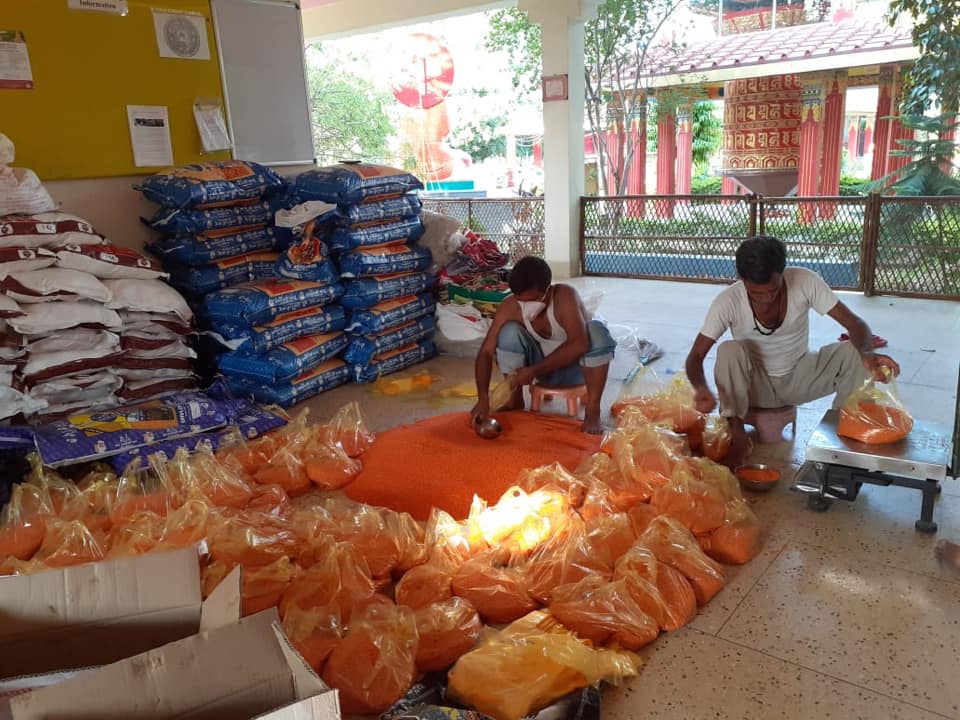
MD Shahid and Binod packaging food at Root Institute, Bodhgaya, Bihar, India, June 2020. Photo by Samten Dolma Bhutia.
Root Institute for Wisdom Culture, the FPMT center in Bodhgaya, Bihar State, India, has been distributing daily staples and food in the local community during the COVID-19 pandemic. Community service is one of FPMT’s Five Pillars of Service.
The online story “Root Institute for Wisdom Culture Helping Local Communities in Need” is an inspiring account of team work, community building, and direct service as told by Root Institute center manager, Samten Dolma Bhutia, who is also managing the food distribution initiative.
“Root Institute had the wish to offer service during the COVID-19 pandemic, especially in our state of Bihar, one of the poorest states in India with a high volume of migrant workers,” Samten writes. “The merit-multiplying month of Saka Dawa helped us set this course into action. By the blessing of Lama Zopa Rinpoche we began distributing food in May, funded by Root Institute. In June 2020, we received a donation from the Tzu Chi Foundation in Taiwan for food distribution around the Buddhist holy sites of Bodhgaya and Sarnath, and began distributing food on their behalf on June 5.”

Lucy Khujur and village representative Ravi helping with food distribution in Sukhandi Village, Bihar State, India, July 2020. Photo by Samten Dolma Bhutia.
As of their most recent food distribution on September 14, Root Institute staff have packed and distributed more than 1,400 bags of food in more than ten villages as well as the Veda Orphan Old Age Home in Bodhgaya.
Lama Zopa Rinpoche sent a message, “Benefits of Charity: Root Institute’s Food Distribution Program during COVID-19,” to Root Institute, rejoicing in their work:
“Thinking from the side of the beneficiaries, these are times of great hardships for them, and help has arrived in their utmost time of need. When we are extremely poor with nothing left to eat and when someone helps us in such a time of need, imagine how extremely happy and appreciative we feel. By this you know exactly what it’s like.”
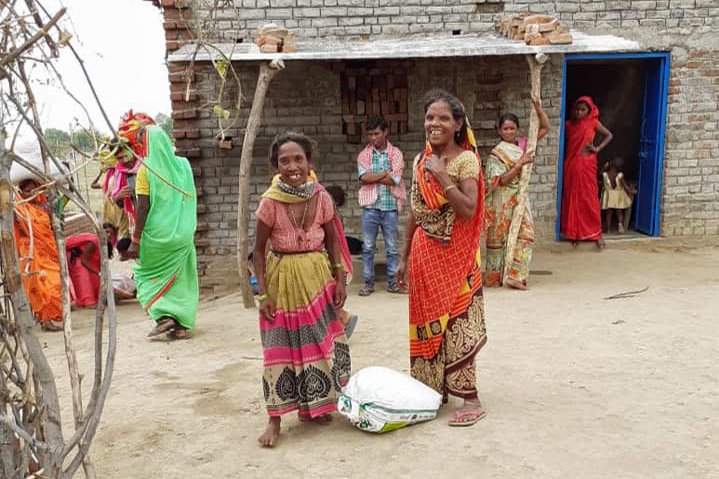
Barachati Village, Bihar State, India, June 2020. Photo by Samten Dolma Bhutia.
Read the complete online story “Root Institute for Wisdom Culture Helping Local Communities in Need” and Rinpoche’s entire message:
https://fpmt.org/mandala/in-depth-stories/root-institute-for-wisdom-culture-helping-local-communities/
For more information about Root Institute for Wisdom Culture, visit their website:
https://www.rootinstitute.ngo
FPMT.org and Mandala Publications brings you news of Lama Zopa Rinpoche and of activities, teachings, and events from over 160 FPMT centers, projects, and services around the globe. If you like what you read, consider becoming a Friend of FPMT, which supports our work.
30
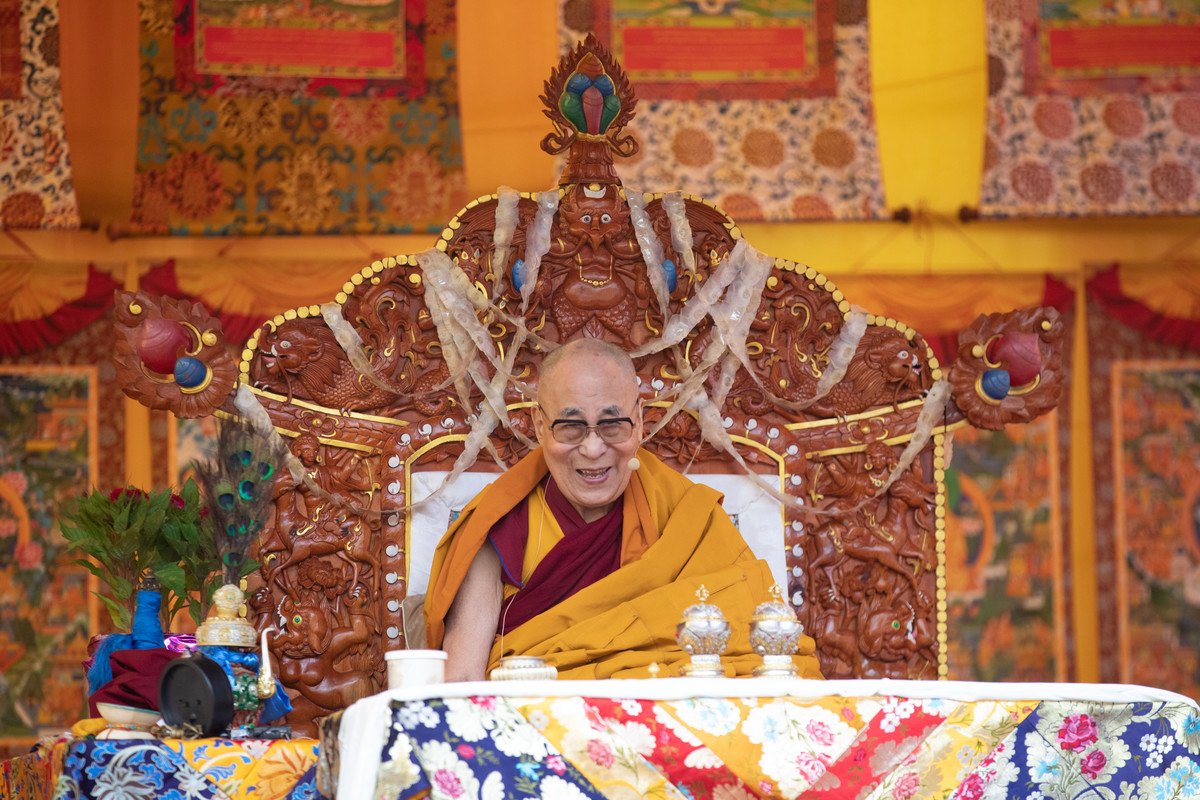
His Holiness the Dalai Lama, Bodhgaya, Bihar, India, January 2020. Photo by Neal Patrick.
Dharma students and the general public have the ongoing opportunity to watch and study with His Holiness the Dalai Lama via live webcast during the coronavirus pandemic.
The next live webcast of His Holiness will be a three-day teaching on October 2–4, 2020. His Holiness will teach on Lama Je Tsongkhapa’s Essence of True Eloquence (tangnye lekshey nyingpo) and Chandrakirti’s Entering the Middle Way (uma jukpa) beginning each day at 9 A.M. India Standard Time (UTC+5:30). (You can find your local time using a time zone converter.)
His Holiness is broadcasting from his residence in Dharamsala, Himachal Pradesh, India. This teaching is being given at the request of Taiwanese Buddhist students. People are requested to please follow social distancing rules while viewing the live webcast.
His Holiness’s teachings will be translated live into English, Chinese, Hindi, French, Russian, Spanish, Vietnamese, Japanese, Mongolian, Korean, German, Portuguese, and Italian. Links for translations are available on dalailama.com/live.
Students not able to watch the live webcasts of His Holiness’s teachings can watch recordings of them online. They are available on dalailama.com/videos and the Dalai Lama Archive YouTube channel.
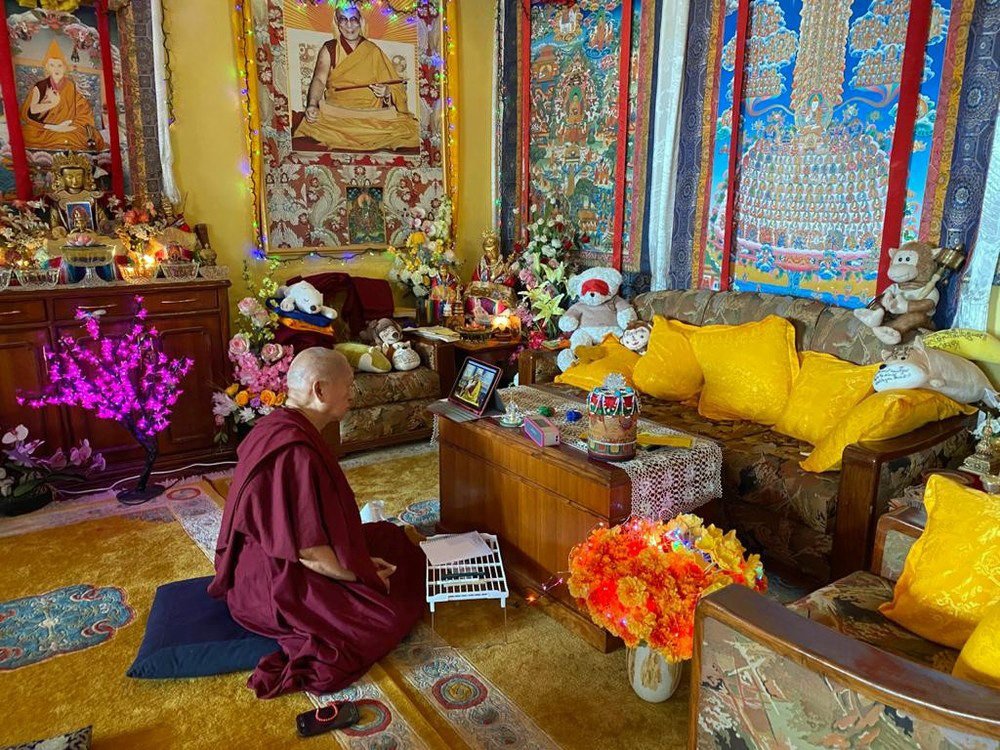
Lama Zopa Rinpoche watching His Holiness the Dalai Lama’s live webcast from Kopan Monastery, May 2020. Photo by Ven. Roger Kunsang.
His Holiness’s first live webcast, a two-day teaching on Nagarjuna’s Precious Garland, was given on May 16–17, 2020. The Office of His Holiness the Dalai Lama wrote, “Today, for the first time, His Holiness the Dalai Lama gave a teaching with no one sitting in front of him that was captured on video and webcast to the world.”
His Holiness began the webcast by remarking, “We are using this marvelous technology, which is quite amazing, for today’s teaching. The main reason is that many people whom I know—my friends and others who may have interest—and I used to have meetings. Due to the pandemic there are restrictions on meeting people. Therefore, we have this difficulty, so we are doing this teaching via webcast. Some people have requested I give some talk, and I thought it was a very good idea to do so.”
His Holiness will give a three-day teaching on November 5–7, 2020, on Nagarjuna’s Commentary on Bodhicitta (jangchup semdrel), beginning each day at 9 A.M. India Standard Time (UTC+5:30). This teaching is being given at the request of Russian Buddhists.
Dates for online talks and teachings with His Holiness can be found as they are announced on the regularly updated schedule for His Holiness: dalailama.com/schedule.
For more on His Holiness the Dalai Lama and his beneficial activities, please visit DalaiLama.com.
FPMT.org and Mandala Publications brings you news of Lama Zopa Rinpoche and of activities, teachings, and events from over 160 FPMT centers, projects, and services around the globe. If you like what you read, consider becoming a Friend of FPMT, which supports our work.
- Tagged: dalai lama, dharamsala, his holiness the dalai lama, webcast, webcasts
21
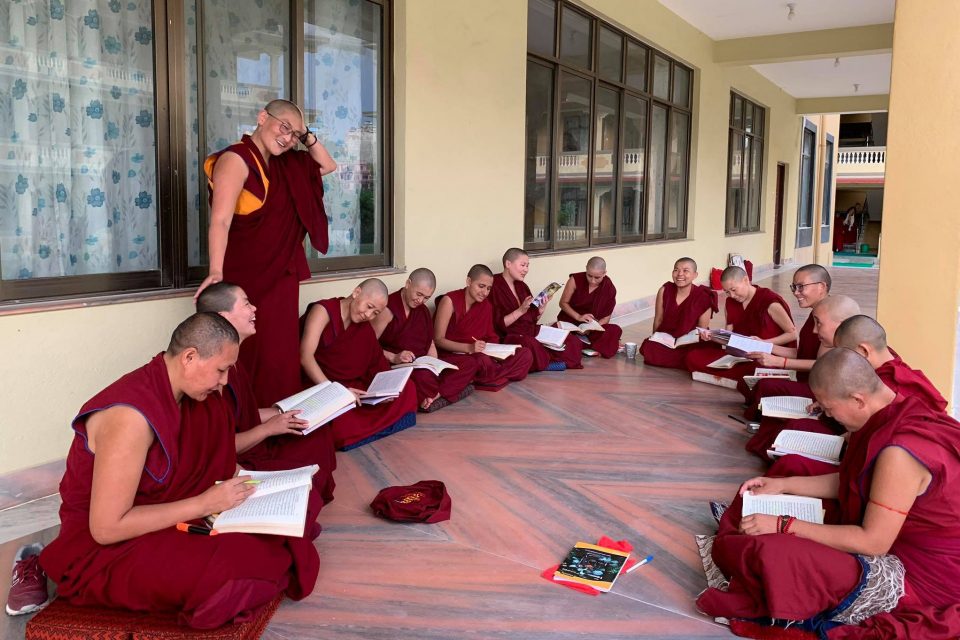
Geshema Namdrol Phuntsok leading a discussion group at Kopan Nunnery, Kathmandu, Nepal, September 2020. Photo by Ani Lobsang Drolma.
Monks have held the Jang Guncho, the winter debate festival, for centuries. The first Nuns’ Jang Guncho took place in Dharamsala, India, in 1995. An annual event, the Nuns’ Jang Guncho is an opportunity for nunneries to gather together to train in and practice debate. The 2018 Nuns’ Jang Guncho took place at Khachoe Ghakyil Ling Nunnery (Kopan Nunnery), an FPMT nunnery in Kathmandu, Nepal. Ani Lobsang Drolma, from Khachoe Ghakyil Ling, shares about the Jang Guncho in 2020 and how its been affected by the pandemic.
In mid-August, Kopan Nunnery started the Jang Guncho, the month-long winter debate session. Most of the Kopan senior nuns, except for the staff, participated in this festival.
The famous event originated in Central Tibet in the monasteries and nunneries west of Lhasa. The focus is on logic, using the text Pramanavartika (Commentary on Valid Cognition) by Dharmakirti.
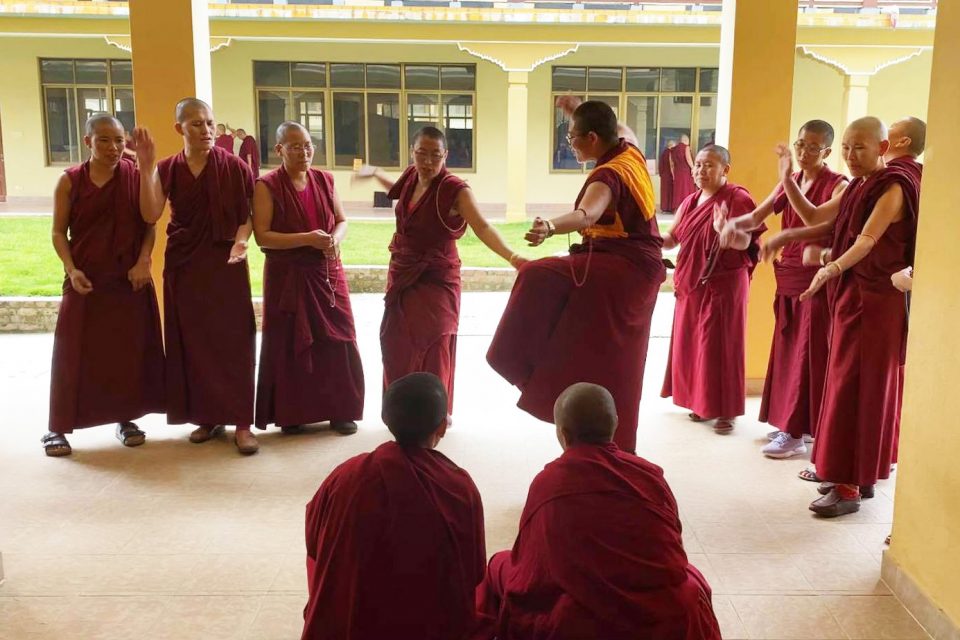
Geshema Namdol Phuntsok teaching debate by example with her students at Kopan Nunnery, Kathmandu, Nepal, September 2020. Photo by Ani Lobsang Drolma.
This inter-monastic debate festival has been held annually. Currently organized by the Tibetan Nuns Project, the Gelug nunneries in Nepal and India would usually gather together to debate with each other, with each institution taking turns hosting. Unfortunately this year plans to gather in India had to be canceled due to the pandemic. For months nuns haven’t left their nunneries as a precaution to prevent possible exposure to the virus.
The younger nuns, who are still in school subjects such as language, science, and math, continue with their studies and prayer memorization. Only the nuns who have graduated from these subjects and now study Buddhist philosophy participate in the festival. During this month, only Pramanavartika is studied in depth and debated. The schedule is intense, with two debate sessions daily, and ongoing memorization and discussion of logic in between.
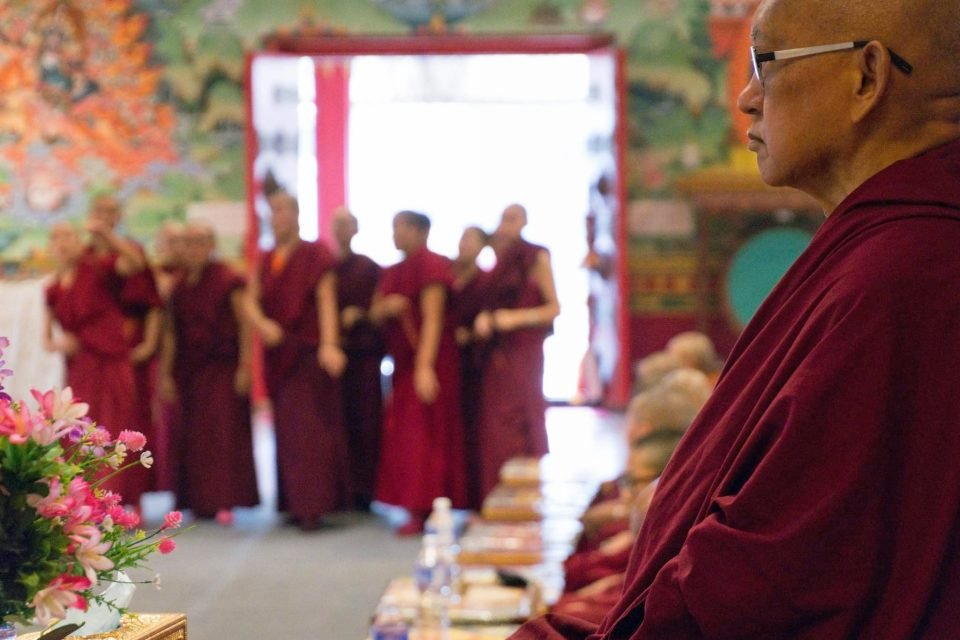
Lama Zopa Rinpoche at Kopan Nunnery, Kathmandu, Nepal, September 2020. Photo by Ven. Thubten Choying.
The winter debate festival ended on September 15. The tsenphue dhamcha, a night group debate between the classes, was held that day from 4 p.m. until midnight. Lama Zopa Rinpoche and nunnery abbot Khen Rinpoche Geshe Chonyi, who are both staying at nearby Kopan Monastery, visited the nunnery to listen to the nuns debate and then left at dinner time. Rinpoche gave a precious teaching before he left, and he appear to be very happy with the nuns. The next day was the final day of the Yarne, the summer retreat.
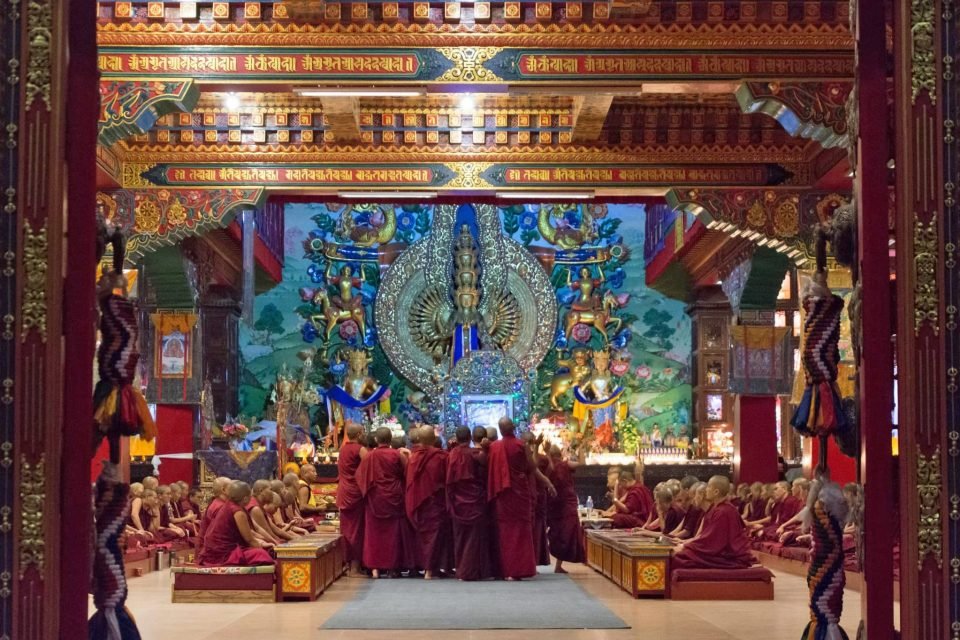
Tsenphue Dhamcha at Kopan Nunnery, Kathmandu, Nepal, September 2020. Photo by Ven. Thubten Choying.
Now that both the Jang Guncho and the Yarne are finished the nuns are getting a holiday for a week. However, many nuns are busy with their Gelug college exam preparations. The rest of the nuns will have good break.
Watch a one-minute video of the Kopan nuns debating during the Jang Guncho:
https://youtu.be/sUKC1HPX1zc
For more information about Kopan Nunnery, visit their website:
http://www.khachonunnery.org/
FPMT.org and Mandala Publications brings you news of Lama Zopa Rinpoche and of activities, teachings, and events from over 160 FPMT centers, projects, and services around the globe. If you like what you read, consider becoming a Friend of FPMT, which supports our work.
- Tagged: ani lobsang drolma, debate, jang gunchoe, kopan nunnery, ven thubten choying, ven. namdrol phuntsok, winter debate, winter jang debate, yarne
17
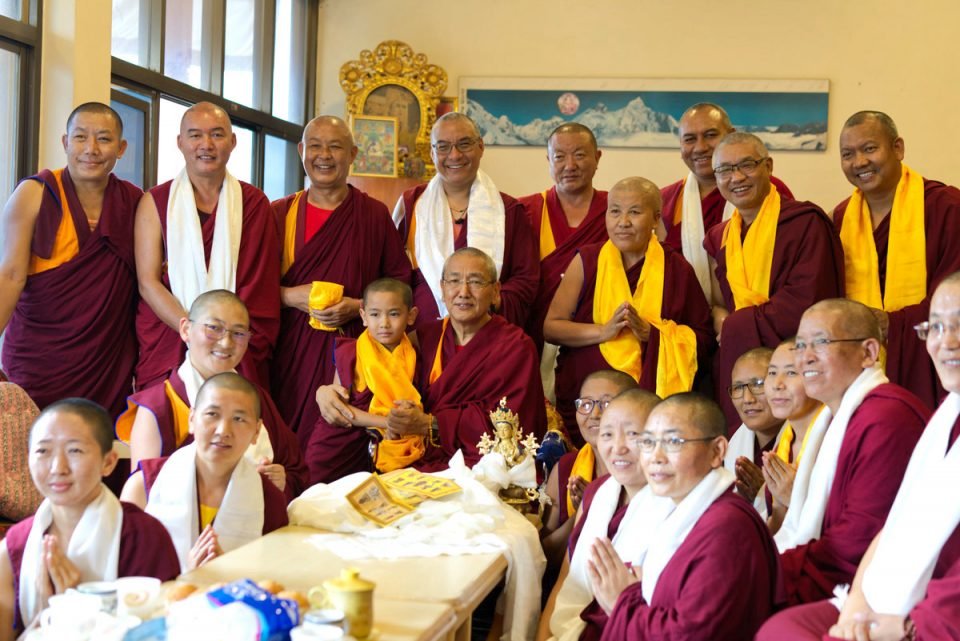
Khen Rinpoche Geshe Thubten Chonyi with some of Kopan’s nuns and monks celebrating his birthday at Kopan Monastery, Kathmandu, Nepal, July 2020. Photo by Ven. Lobsang Sherab.
Khen Rinpoche Geshe Thubten Chonyi is abbot of Kopan Monastery and Kopan Nunnery, the FPMT monastic institutions in Kathmandu, Nepal, and resident geshe at Amitabha Buddhist Centre (ABC), the FPMT center in Singapore. The online story “A Deep Interest in Study: Khen Rinpoche Geshe Thubten Chonyi’s Story and the History of Kopan,” based on a July 2020 video interview, tells of Khen Rinpoche’s experience from when he was a boy in the Solu Khumbu District of Nepal to being a monk at Kopan in the 1970s to becoming the abbot of Kopan Monastery. Here’s a short excerpt from the story:
Four or five years after Khen Rinpoche began his monastic studies at Kopan, Khen Rinpoche’s older brother, who was living in Kathmandu, advised Khen Rinpoche to leave the monastery and go to a school, thinking his brother wasn’t really studying at the monastery. When Khen Rinpoche consulted Khensur Rinpoche Lama Lhundrup, who was overseeing monastic education at Kopan, Khensur Rinpoche said, “If you go to a school what can you achieve? Just the basic knowledge, not much more than that. But then you are also creating so much negative karma in your life. So even if you don’t learn much, it is better to stay in the monastery. In this way every day you can collect merit all the time.”
Many teachers from Sera Je Monastery in South India, such as Geshe Doga and Geshe Jampa Gyatso, came to visit Kopan Monastery and teach philosophy. Scholastic monks from Sera Je Monastery also would sometimes stay at Kopan while on pilgrimage in Kathmandu. “Then we had to debate with them,” Khen Rinpoche explains. “Most of us were not good in debate at that time, so we were very nervous to debate with them. … I noticed that whatever questions were asked to the monks from Sera, they answered very well.” This inspired Khen Rinpoche to want to know everything about Buddhist philosophy.
In 1980, Khensur Rinpoche Lama Lhundrup, Lama Yeshe, and Lama Zopa Rinpoche decided to send twelve Kopan monks to Sera Je Monastery to study. Lama Yeshe and Khensur Rinpoche asked Khen Rinpoche if he would want to go to Sera, which he did.
Khensur Rinpoche then accompanied the group of Kopan monks to Sera Je Monastery and stayed with them for the first month. Feeling discouraged after the first month, Khen Rinpoche told Khensur Rinpoche that he didn’t understand anything and wanted to return to Kopan. Khensur Rinpoche said, “One month is too short. So you must stay longer and try.” …
Watch “The Story of Khen Rinpoche Geshe Thubten Chonyi and the History of Kopan Monastery” on YouTube:
https://youtu.be/-4GMJ-68xI8
Read the complete online story “A Deep Interest in Study: Khen Rinpoche Geshe Thubten Chonyi’s Story and the History of Kopan”:
https://fpmt.org/mandala/in-depth-stories/khen-rinpoche-geshe-thubten-chonyi/
FPMT.org and Mandala Publications brings you news of Lama Zopa Rinpoche and of activities, teachings, and events from over 160 FPMT centers, projects, and services around the globe. If you like what you read, consider becoming a Friend of FPMT, which supports our work.
You can find more information about Kopan Monastery and Kopan Nunnery online.
- Home
- News/Media
- Study & Practice
- About FPMT Education Services
- Latest News
- Programs
- New to Buddhism?
- Buddhist Mind Science: Activating Your Potential
- Heart Advice for Death and Dying
- Discovering Buddhism
- Living in the Path
- Exploring Buddhism
- FPMT Basic Program
- FPMT Masters Program
- FPMT In-Depth Meditation Training
- Maitripa College
- Lotsawa Rinchen Zangpo Translator Program
- Universal Education for Compassion & Wisdom
- Online Learning Center
- Prayers & Practice Materials
- Overview of Prayers & Practices
- Full Catalogue of Prayers & Practice Materials
- Explore Popular Topics
- Benefiting Animals
- Chenrezig Resources
- Death & Dying Resources
- Lama Chopa (Guru Puja)
- Lama Zopa Rinpoche: Compendium of Precious Instructions
- Lama Zopa Rinpoche: Life Practice Advice
- Lama Zopa Rinpoche Practice Series
- Lamrim Resources
- Mantras
- Prayer Book Updates
- Purification Practices
- Sutras
- Thought Transformation (Lojong)
- Audio Materials
- Dharma Dates – Tibetan Calendar
- Translation Services
- Publishing Services
- Teachings and Advice
- Find Teachings and Advice
- Lama Zopa Rinpoche Advice Page
- Lama Zopa Rinpoche: Compendium of Precious Instructions
- Lama Zopa Rinpoche Video Teachings
- ༧སྐྱབས་རྗེ་བཟོད་པ་རིན་པོ་ཆེ་མཆོག་ནས་སྩལ་བའི་བཀའ་སློབ་བརྙན་འཕྲིན།
- Podcasts
- Lama Yeshe Wisdom Archive
- Buddhism FAQ
- Dharma for Young People
- Resources on Holy Objects
- Ways to Offer Support
- Centers
- Affiliates Area
- Teachers
- Projects
- Charitable Projects
- Make a Donation
- Applying for Grants
- News about Projects
- Other Projects within FPMT
- Support International Office
- Projects Photo Galleries
- Give Where Most Needed
- FPMT
- Shop
Subscribe to FPMT News
Translate*
*powered by Google TranslateTranslation of pages on fpmt.org is performed by Google Translate, a third party service which FPMT has no control over. The service provides automated computer translations that are only an approximation of the websites' original content. The translations should not be considered exact and only used as a rough guide.Death could come any minute so transform your life into Dharma.







